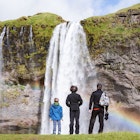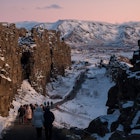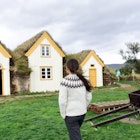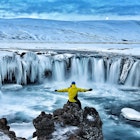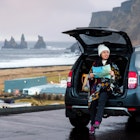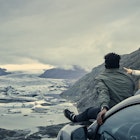Iceland’s wild western coast has bred a long line of storytellers, who shared tales of super-human Vikings and meddlesome spirits across the millennia. We meet the people keeping the tradition alive and the landscapes that inspire them.
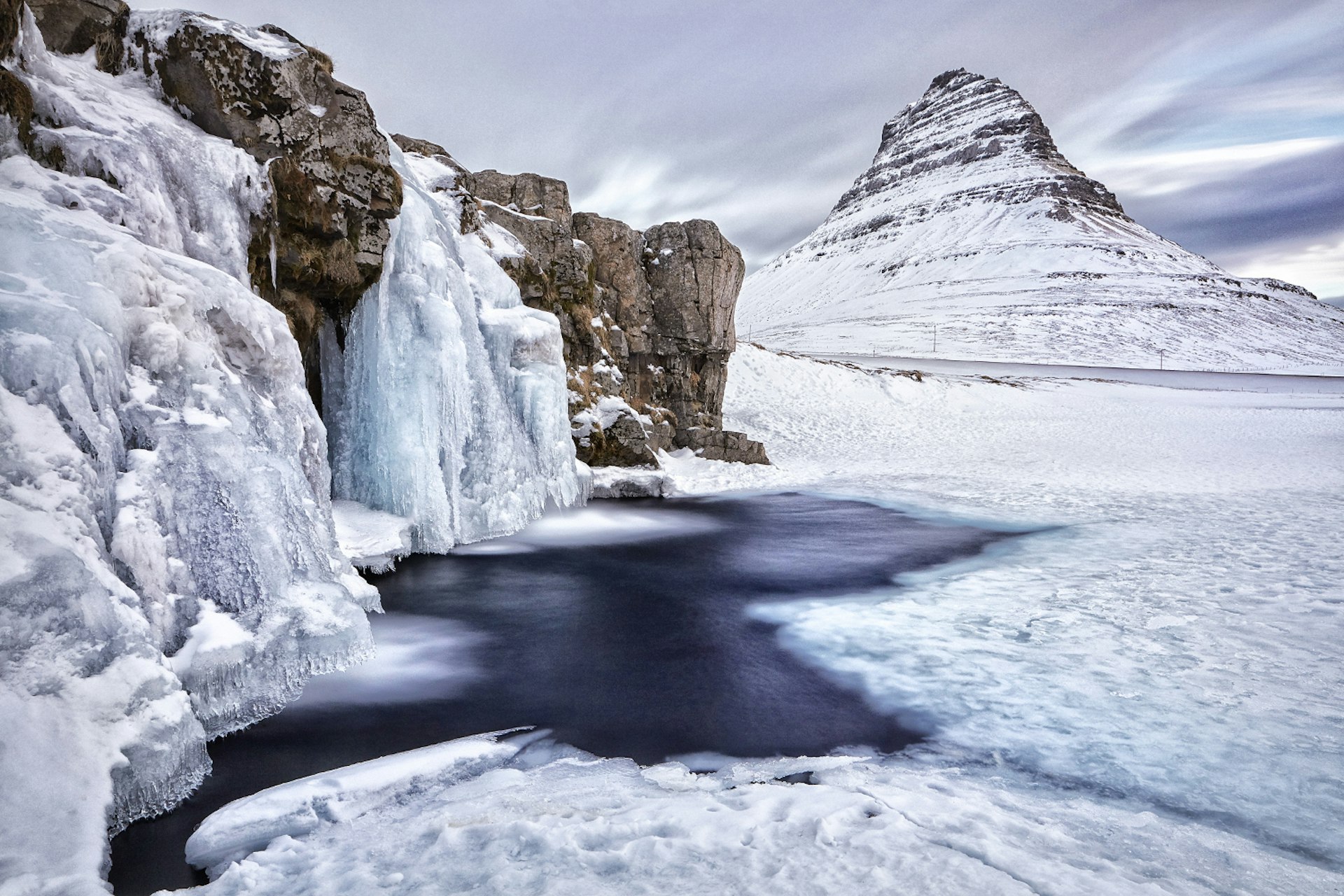
The man who lives with trolls
It’s a clear day when the two trolls set out on their journey. Snow sits on the distant mountains, but the valley is green and full of summer. Frazzled hair running amok above pale faces, the pair bob merrily through the hills. Their journey soon comes to an abrupt halt – a giant hand swoops in from above and yanks them into the firmament.
‘So this is my little theatre,’ explains Ingi Hans, inspecting the wooden puppets in the playhouse he conjured up from bits of scrap and uses to entertain children in his hometown of Grundarfjörður. He wheels it across the floor of his workshop – a building known to everyone in the region as the Storyteller’s Lodge – to join the other paraphernalia he’s amassed over the years: old cash machines, ships’ lanterns, tin cars, leather-bound books, vintage Barbie dolls still in their boxes.
Ingi, the thin strip of white beard running down his chin lending him a faint air of wizard, has been collecting and telling stories his entire life. ‘My father was a fisherman and every day I would visit an old man at the harbour who was fixing the nets,’ he says, hands clasped round a freshly brewed mug of coffee. ‘He was always telling stories. My father would come home from the sea and I would share them with him.’

The door swings open and his young grandson comes in, a whirl of snow blowing through behind him. He heads straight to the theatre and starts playing with the trolls.
‘Here we are all storytellers,’ says Ingi. ‘Maybe it’s our Celtic heritage, but our landscape and long winters also have an affect. We started to collect myths, to bring them back to life, to help us through the cold nights.’
I ask him if he believes in the huldufólk, the mysterious ‘hidden people’ often incorrectly translated as ‘elves’ in English. ‘I have not much experience of them,’ he says, ‘but if you reject everything you don’t know, you believe in nothing.’
He points out of the window to a dark mountain beyond the town. ‘And, of course, we have many trolls in Iceland and you see them everywhere.’ He traces the craggy ridges of the rock’s upper reaches with his finger. ‘That’s a female troll right there.’
The lady and the magic icicles
The road out of Grundarfjörður follows the coast west, slick and black and solid in a land of murk. Colour is hard to come by in the thick of winter on Snæfellsnes: stiff golden blades of grass rise through the snow on the black beaches ringing the peninsula; and metre-thick ice sheets dripping down rock faces glow turquoise, as if lit from within. At dawn, a stripe of electric pink momentarily enlivens the pallid sky above Kirkjufellsfoss, a stack of waterfalls guarded by a mountain in the shape of a witch’s hat.
Water emerges beneath a thick hood of ice at the falls’ edge, collecting in black pools below. Broken icicles litter the ground like abandoned swords. ‘In Iceland, we say icicles are Grýla’s candles,’ says Ragnhildur Sigurðardóttir, picking her way over the frozen ground. ‘She was an ogre and her 13 sons, the Yule Lads, terrorised children for 13 days before Christmas. She ate her first two husbands.’
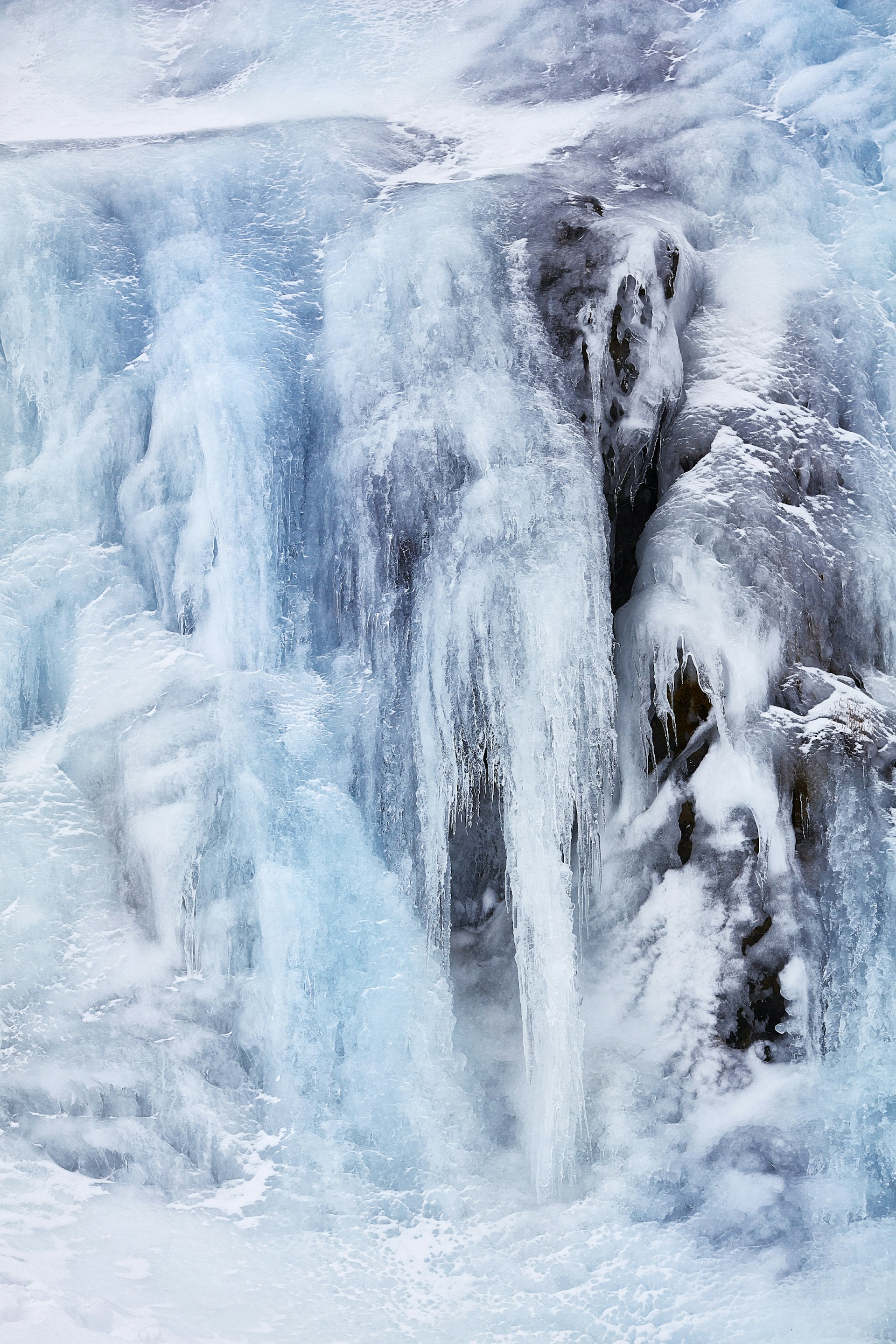
As manager of Snæfellsnes Regional Park, Ragnhildur is fascinated by the link between landscape and myth. Like many native Icelanders, she can trace her family tree back to the country’s first Viking settlers, who rowed over the ocean from Norway over a millennia ago. ‘Iceland doesn’t have an architectural heritage but we do have a heritage of storytelling,’ she says, flame hair riffled by the rising wind. ‘We can go to any place and know who lived there, who they loved, who were their enemies.’
Adventurers and pioneers, and often renegades and social outcasts, the people who made it to these shores had a natural propensity for hyperbole, and embellished their reputations with claims of super-human strength to keep their farms safe from marauders. Their legend grew more fantastical with every successive retelling through the generations. The saga of one of the region’s first settlers, Bárður Snæfellsás, was first written in the 15th century, and tells of a man whose father was half-giant and whose daughter was set adrift on an ice-sheet to Greenland. Bárður himself became a half-troll and is said to live in Snæfellsjökull glacier, atop the flat volcano that squats over Snæfellsnes peninsula.
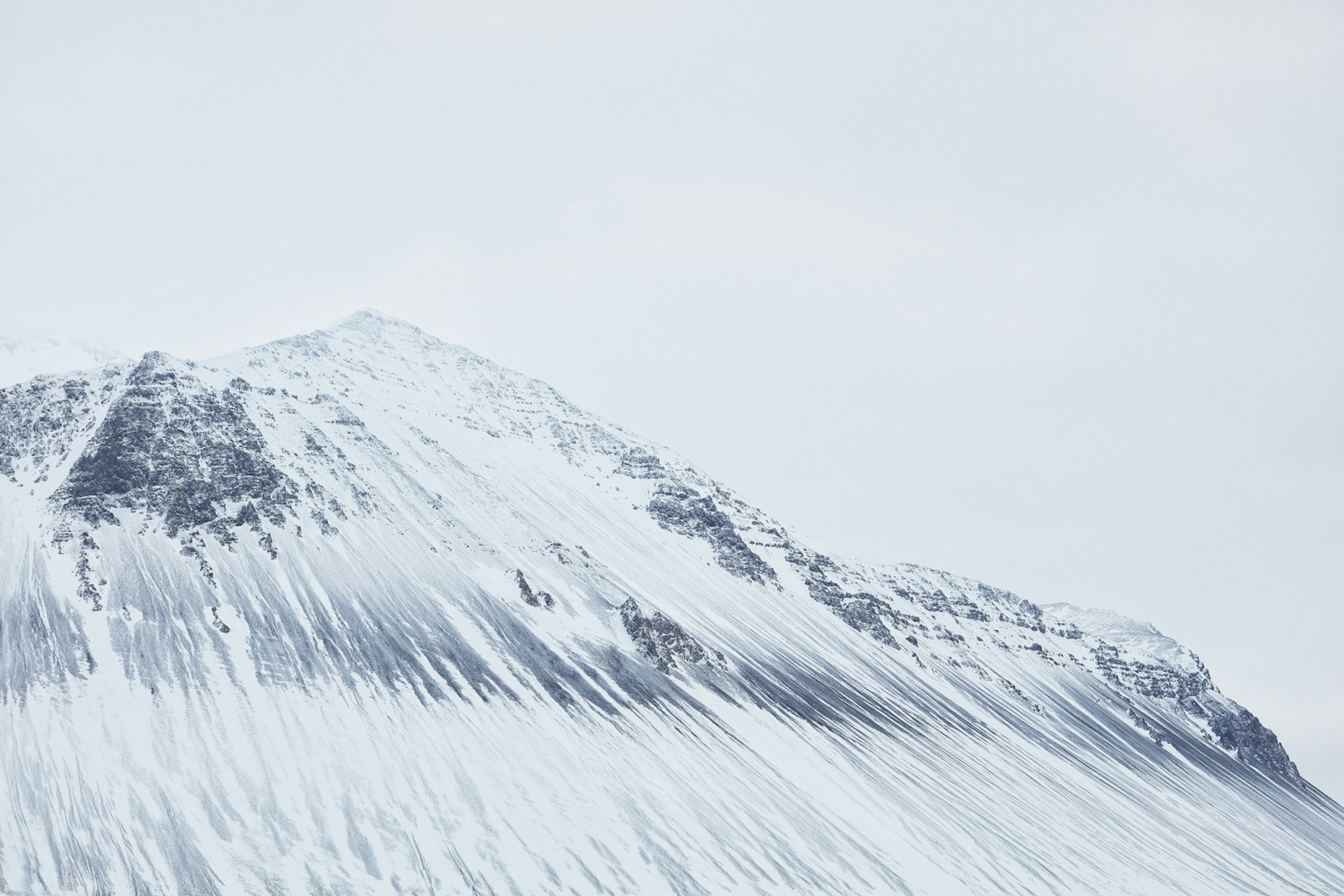
‘There is a lot of magic in our stories and in our nature,’ says Ragnhildur, as a pale, part-time sun inches above the horizon. ‘It’s alive in all of Iceland, but especially here. On every farm, on every mountain, there is a story with some magic in it. People are reluctant to talk about it because they don’t want to look stupid... but the stories always come out eventually.’
The huldufólk and the candlestick
A deep waft of ammonia creeps up the nostrils as Hildibrandur Bjarnason leads the way through Bjarnarhöfn. Hildibrandur is the latest custodian of a farm that has stood on this patch for more than 1,100 years. Machinery lies half-buried in the snow on fields that slope down to a wide, island-flecked bay. Nine-hundred years ago, traders from northwest England landed here to buy fish, fish oil and meat. Visitors still come today, but for one product alone: hákarl, Iceland’s infamous fermented shark dish.
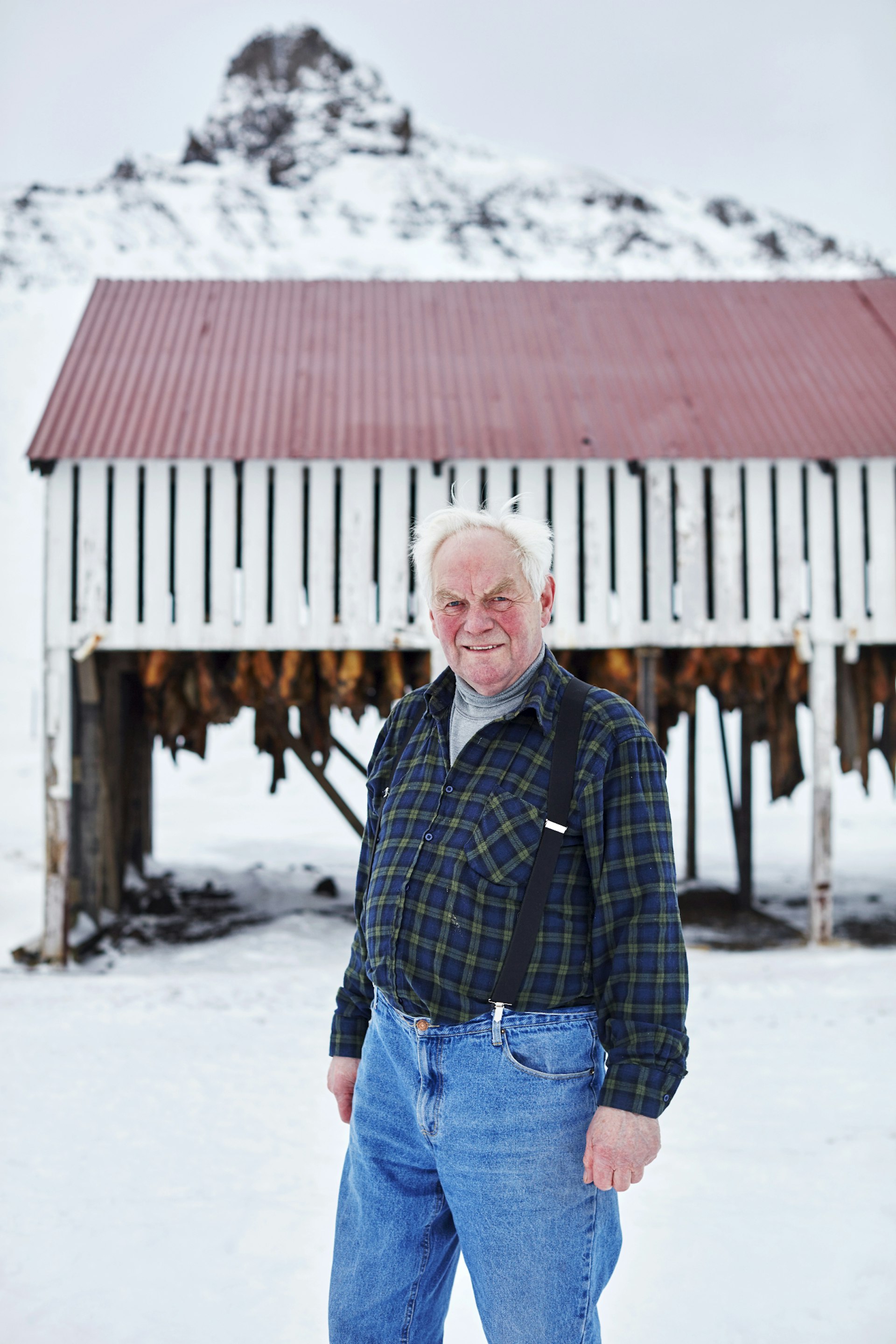
The brown hunks of meat have been hanging from rafters in a tin barn open to the elements for the past four months. Hildibrandur, cheeks whipped red and white hair bullied by a bitter wind, slices a strip with a penknife and we try it: it’s not unpleasant, a bit like a very ripe blue cheese.
Keen to share Bjarnarhöfn’s other riches, Hildibrandur heads into the museum he and his son Guðjón have set up in one of the outbuildings. It is brim-full with artefacts from their family, collected generation after generation: taxidermy guillemots; a wooden fishing boat; knitting machines; shoes made from fish skin; pans for boiling potatoes; harnesses, ropes and tools. ‘We weren’t planning to go into tourism,’ says Guðjón, ‘but people started coming to take a look, and it grew like a snowball.’
The family’s most treasured possession is not, however, on display. Hildibrandur’s eyebrows shoot up in excitement when conversation turns to the farm’s inhabitants. ‘There are six people registered here,’ he says, ‘but many more live here. I feel them around, and many people have seen them.’
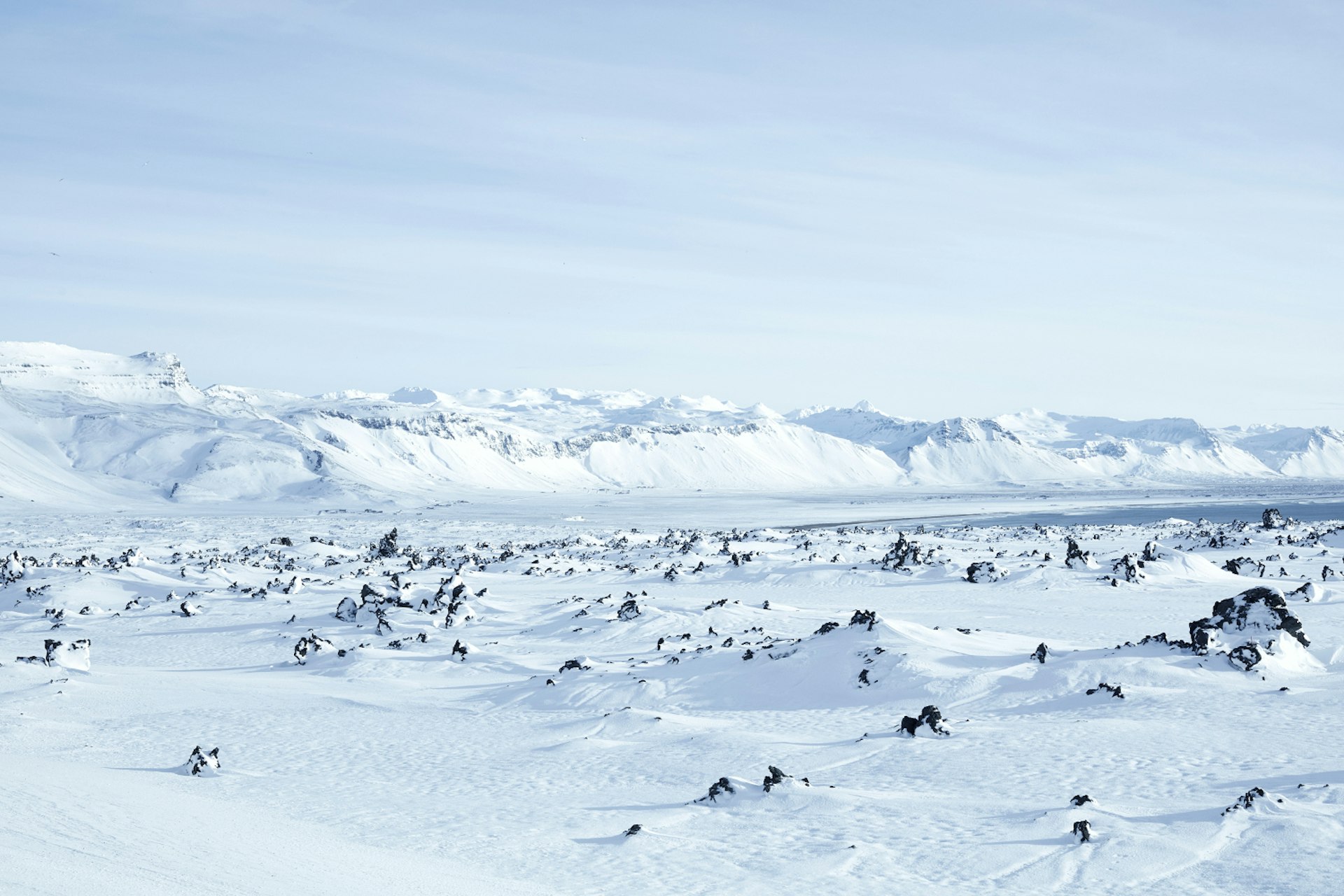
He stands at the window and gazes out towards the bay, hands buried in baggy jeans held up by braces, and tells of a relative who, long ago, woke in the night to find a huldu man at her bedside asking for help with his wife’s labour. She went with him, and the baby came and was healthy. The huldufólk were poor and only had a candlestick to give as thanks. ‘When she wakes,’ says Hildibrandur, ‘she has blood on her hands, her feet are dirty, and the candlestick is on the table.’ He takes out his mobile and shows me a photo of a brass candlestick. ‘The family still has it. It is always polished and in the centre of the table, and with it comes good fortune.’
Guðjón smiles the slightly sceptical smile of a man who’s heard the story many times, but concedes that the old beliefs have a way of taking hold out here, on a remote farm in a remote corner of a remote island far out in the Atlantic. ‘There’s a lot on the farm that we can’t explain,’ admonishes Hildibrandur, heading back out to feed the animals. ‘When we follow the sheep, why does one suddenly turn around for no reason, for example? It is the huldufólk.’ With that, he is out the door. We watch him shuffle through the snow to the ducks and chickens. Perhaps we are not the only ones looking on.
The farmer and the holy grail
Several hours’ drive north along a crinkled coastline lies a spit of land even more cut off than Snæfellsnes. Mist-clad mountains, through which it is possible to travel for hours without seeing another soul, give way to broad valleys traced with rivers whose waters won’t flow again till late spring. Small herds of Icelandic horses stand in frozen fields, pawing at the snow or gathering to nibble on hay bales.

Out on the Atlantic, eider ducks coast on the wind, spending the winter far from land. In May, they will fly into Breiðafjörður Bay, shed their feathers, and build nests from them for their eggs. Waiting for them each year is Snorri Victor Gylfason.
At least 30 generations of Snorri’s family have lived and worked at Skarð, a farm of 8,000 hectares, including 67 islands particularly attractive to eider ducks. In the summer, the family rows out to the islands, replaces the feather nests with wool and retreats to a farm workshop, where the cloud-soft down is used to fill bedding. The Rolls-Royce of duvets, a king-size eider-duck quilt retails for 3,000,000 krona (£20,000).
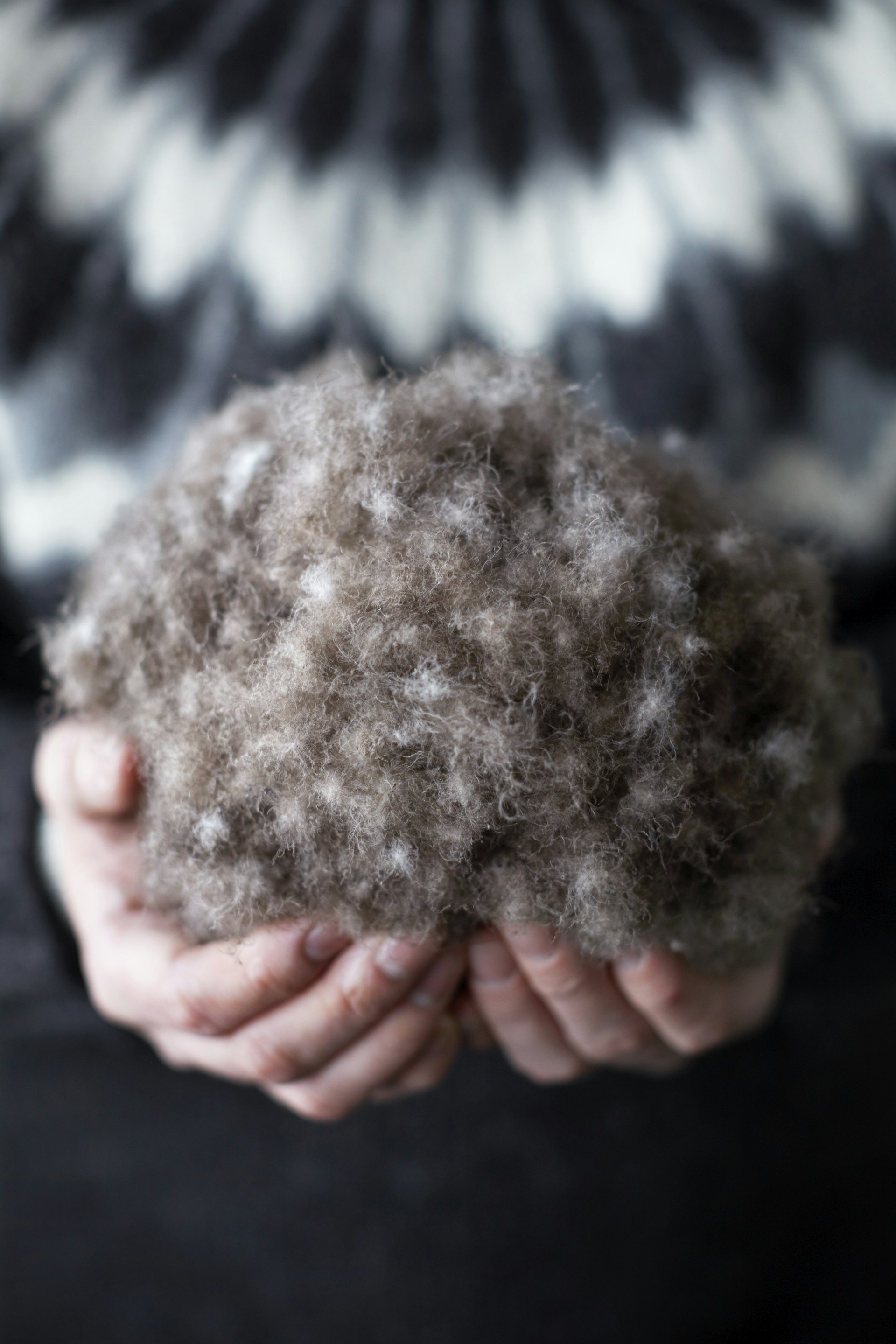
And yet the feathers may be the least valuable thing at Skarð. Snorri pulls out a large iron key and unlocks the door to a small church behind the workshop. It swings open to reveal wooden pews, a curved ceiling splashed with stars and an elaborate carved altar, much coveted by the National Museum of Iceland. ‘The government is always trying to get our stuff, but we won’t let them have it,’ says Snorri with a laugh.
The family’s story is recorded in a book made of calfskin, now held at the national museum, and recounts tales of English pirates, Norwegian kings, slaves and thieves, beheadings and betrayals. His ancestors certainly picked up some trinkets along the way. Snorri pulls out a 400-year-old priest’s robe (‘The national museum told us, at least keep it in a cupboard so it doesn’t get ruined’) and a battered old violin (‘only seven generations old’). He saves his favourite object till last: a golden chalice. ‘This is what I call the Holy Grail. We believe the settlers brought it with them in 900 AD. All the family have their first drink of wine from this cup. We don’t use crystal– that’s for poor people!’ He laughs again. ‘But I’m not much interested in Christian history. I’m much more interested in Odin and Thor, and all those guys.’
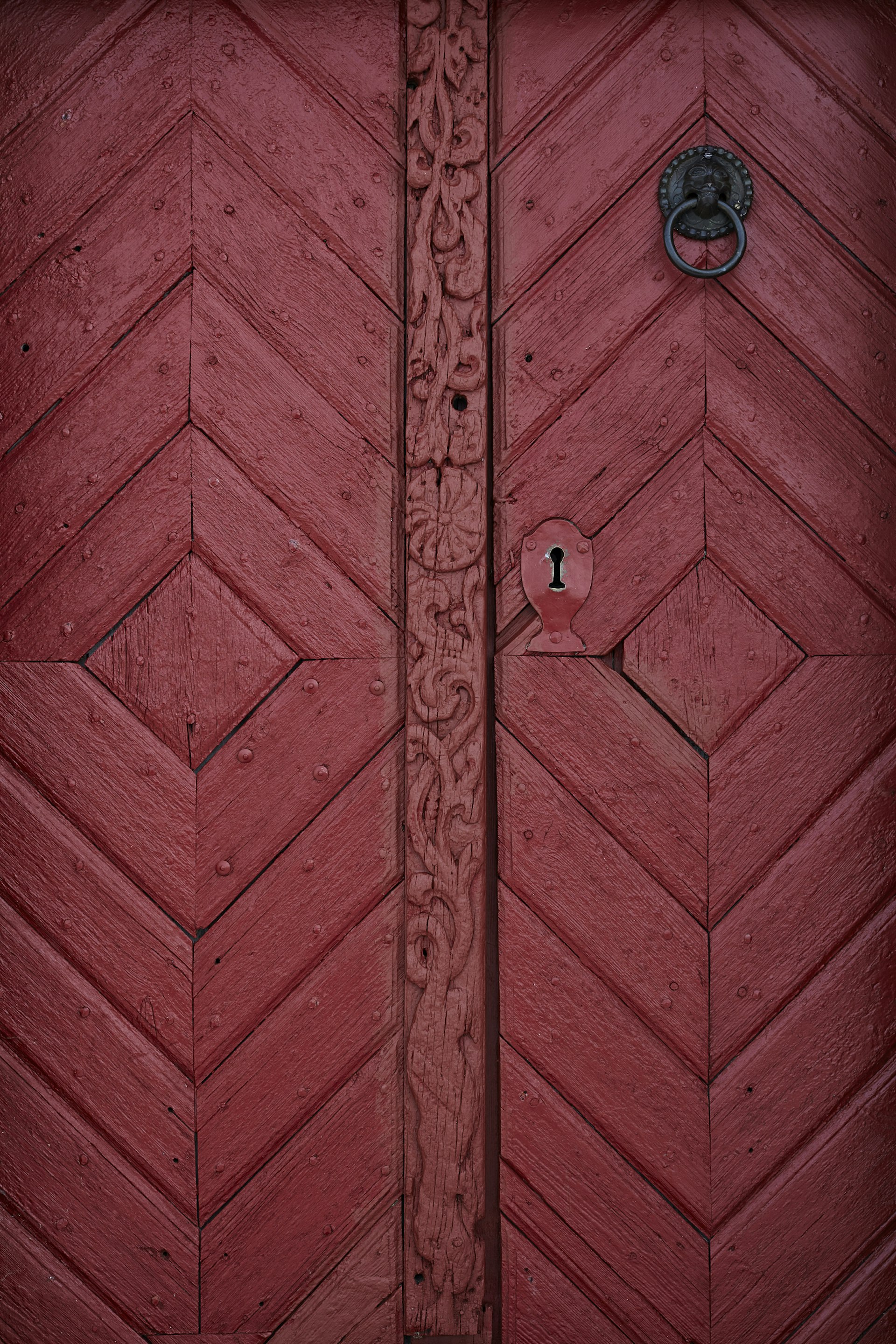
He seals up the church and heads back to work: some of the farm’s 600-strong flock of sheep wait to be herded inside for the night. My inevitable question about huldufólk is greeted with a smile. ‘There are many stories about them,’ he says. ‘They are all true, of course.’
We stroll down to the bay, a break in the clouds casting an ethereal shaft of light on the waters in front of us. ‘But with the long history of the farm and the church, and all the things that have happened here, everyone in this family is really scared of ghosts,’ he says. ‘Strange things go on all the time. People think they are being followed on dark nights. If something bad happens, people say it is Skarðskata, the ghost of Skarð.’
Not wishing to meet Skarðskata, we hurry home before dark falls, the farm’s horses watching silently from the fields as we pass.
The priest and the dark shore
The church at Búðir is still very much a working concern, rather than a depository of family treasures. The simple wooden chapel, overlooked by mountains and with the Atlantic roaring up the beach nearby, has become a popular wedding spot, and Reverend Páll Ágúst has just finished marrying a young British couple, drawn to the wilds of western Iceland. ‘It’s really raw here,’ he says, settling into a pew. ‘People like that it’s in the middle of nowhere.’
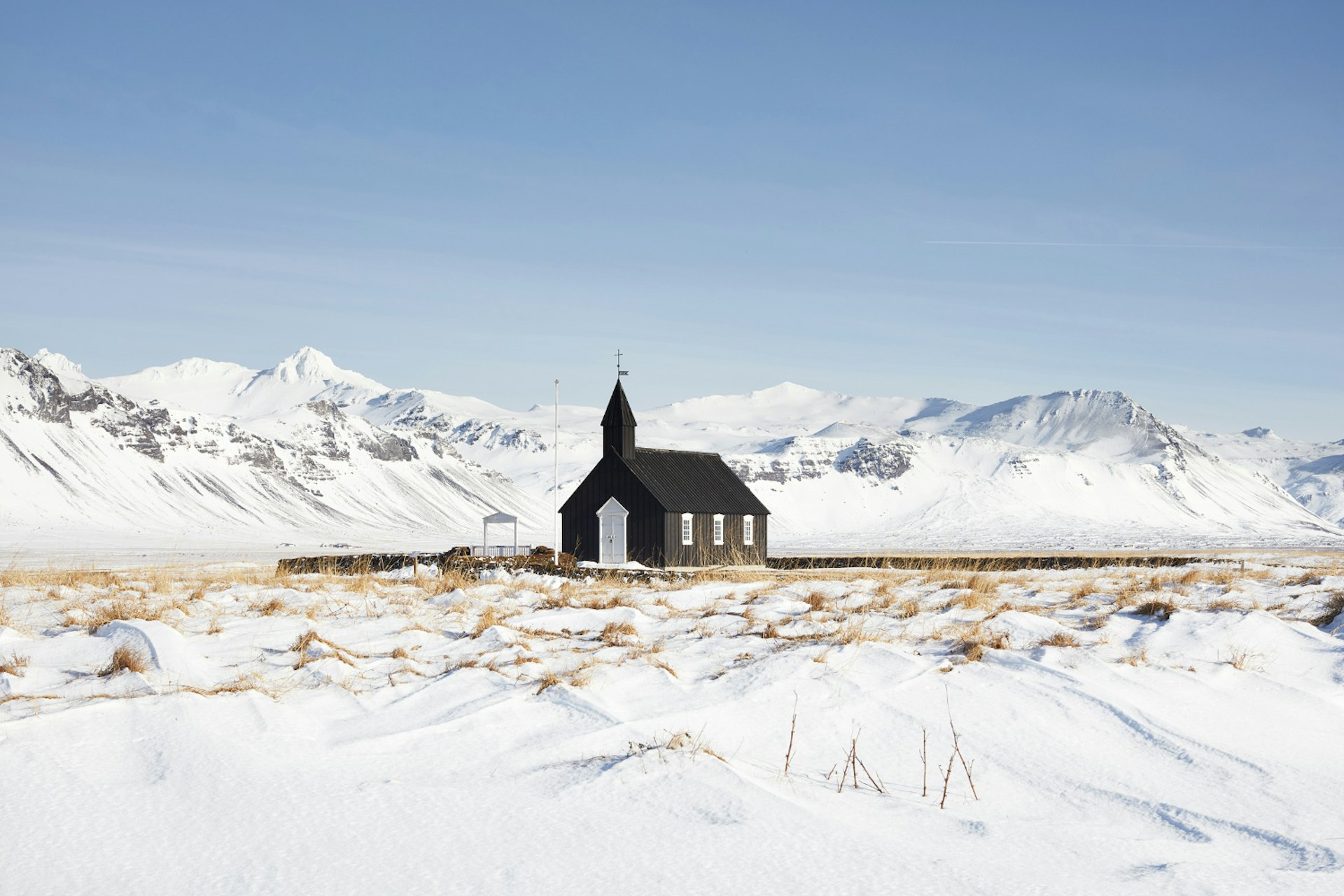
Local belief has it that Páll shares the lava fields surrounding his church with many huldufólk. ‘I don’t believe it myself,’ he says with a cheerful smile. ‘But belief in God doesn’t have to exclude belief in the huldufólk.’ He locks up for the day, ready to visit one of the other seven churches in his parish. ‘Icelanders are fantastic storytellers,’ he says. ‘And the huldufólk are a great story. When you live in the countryside with no connection with the bigger part of the world, it is easy to believe in something that lives in the wind or in the storm.’
He sets off in his car, and I follow him round the coastal road for a while, stopping at the beach at Djúpalónssandur. A steep path leads down from the cliffs through a natural rock arch to the shore, like a gateway to the underworld. Black pebbles shiny as pearls cover a beach littered with the bones of a British trawler, wrecked one stormy night in 1948, with most of the crew lost. The rising tide crashes against the rock stacks that protrude from the ocean, the spray blowing inland in ghostly formations. In the deepening gloom, the cries of the gulls wheeling above sound increasingly like screams, and the dark cliffs looming behind the beach are suddenly menacing, a barrier to safe passage out. It’s clearly time to go.
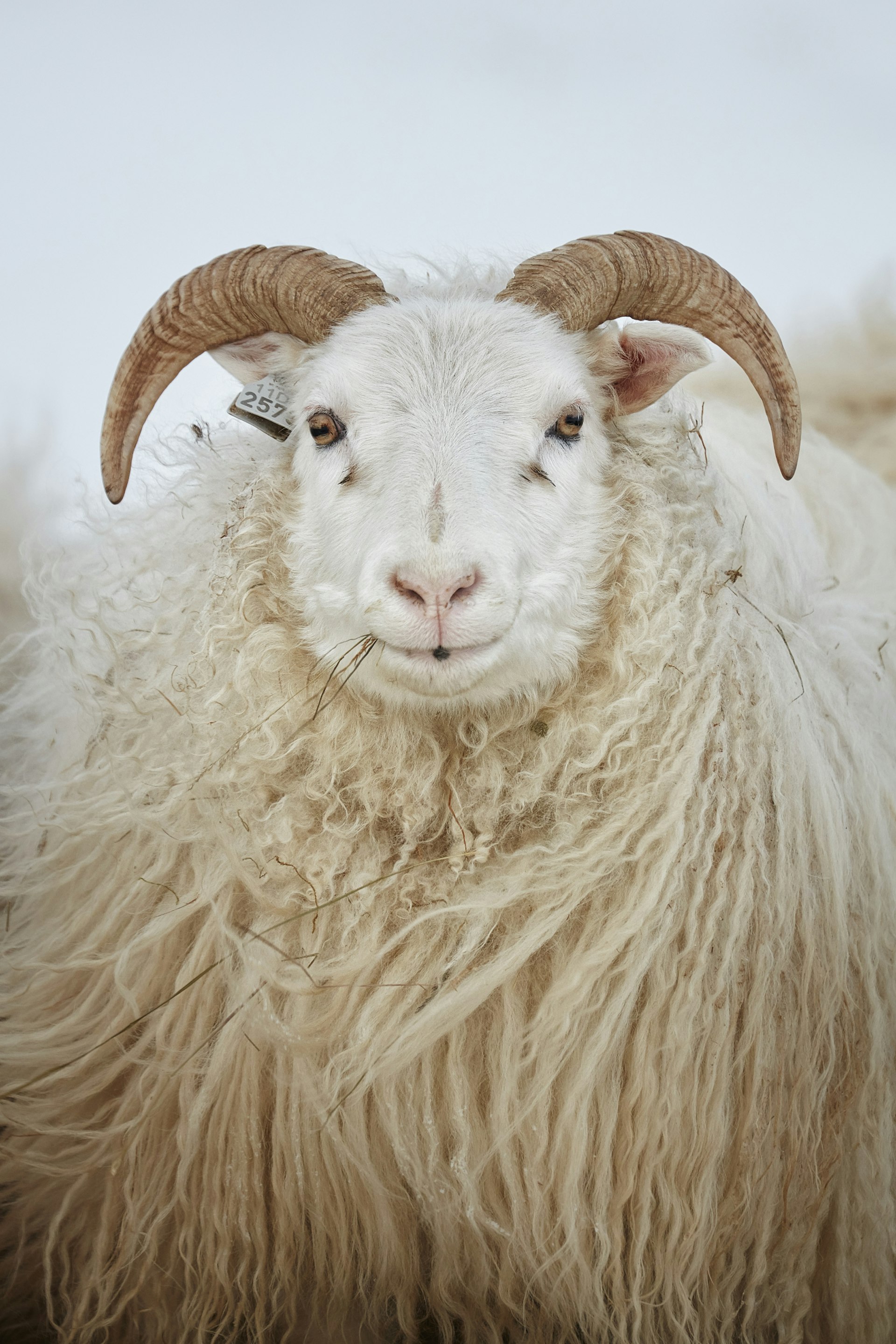
Four sheep appear on the beach, poking about the rusting metal of the shattered fishing boat. They look up and stare, then turn and walk back up through the pass in single file: white sheep, black sheep, white sheep, black sheep. As we climb, they pause several times and turn their heads back, as if to check I’m still behind. Emerging through the rock arch and delivered back to the sanctuary of high ground, I find they’ve vanished.
I salute gods both Christian and Norse, men and huldufólk, ghosts and trolls, then climb into my car, and drive away.
This article appeared in the December 2016 edition of Lonely Planet Traveller Magazine (UK). Subscribe here or download your digital edition now on iTunes or Google Play.
Amanda Canning travelled to Iceland with support from Discover the World (discover-the-world.co.uk). Lonely Planet contributors do not accept freebies in exchange for positive coverage.



